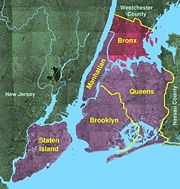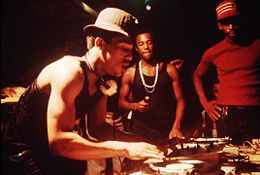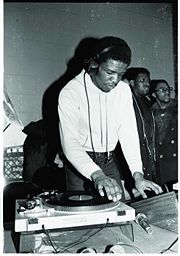| wiki | search |
Main Page | Groups and Assignments | Bios | History | Harlem | Diversity Today | Help
Blacks’ Artistic Empowerment: The Development of Hip-Hop
| Hip-Hop is a dense part of today’s urban music and is heard through the nation, and especially in New York, it’s birthplace. It is almost impossible to go through public transportation, i.e. trains, and buses, walk down the street or even go through the halls college without witnessing the presence of Hip-hop. Nonetheless, Hip Hop is a fairly young form of art and often times because it is so young and diverse, the history and it’s roots are often neglected or not properly emphasized. In addition, massive production and popularity of what is considered present day hip-hop often distracts people from the history of the origins as well. It is important to realize that the development of Hip-Hop in the 1970’s helped blacks, as well as many other "minorities", in New York not only help them express their artistic side through music and dance but also helped in paving the way for massive recognition in the music industry today. In addition, because of its diverse background and mixture of components, which distinguish it from jazz, smooth, and other music of the Harlem Renaissance, it is not limiting in its elements thus inviting to a larger field of audience. South Bronx is the birthplace of Hip-Hop, it comes to no surprise that the intermingling of Puerto Rican and West Indies along with Black styles are the main contributors to the basic Hip-Hop essence. |
| When No One Listened
|
| Often, when people here Hip-Hop they associate it with only African-Americans. However, Hip-Hop is actually the combination of West Indian, Puerto Rican, Blacks of New York. Hip-Hop has always been open to a diverse audience, and thus is not limited to one specific group. DJing started in Jamaica, where the artist would mix and scratch music with repetitive phrases mixed it. In Jamaica, and in many area of the West Indies, music is used as important as politics. Music was used to express the voice of the citizens. Political parties themselves used the musics of DJs to represent their positions. As people from the West Indies moved into New York and specifically the Bronx, they began to incorporate their values of music as a form as expression. When the West Indians began to live with the Puerto Ricans and African Americans of the South Bronx, their art of music mixed in with the rapping and rhyming of the people living there. Hip-Hop began to include in general, Rapping, DJing, Graffiti and Break Dancing. DJ Kool Herc and other DJ from the West Indies, gaining popularity from their style of music, began to encourage the youth to get involved in the art of Hip-Hop. Soon some gangs began to focus their concentration on Hip-Hop rather than using violence to express their anger with the environment they were in. Afrika Bambaataa would find the Universal Zulu Movement, which was a gang that focused on Hip-Hop. What all the people involved in Hip-Hop do have in common is how the merge the struggles of every day life, and their environment into their various forms of art in a way that people facing similar difficulties can also relate. Hip-Hop then turns into a voice of all those New Yorkers, and even beyond, who are constantly trying to improve their lives in a difficult environment. |
Influential People:
Kool Herc- DJing, mixing Jamaican and African American music and styles by ripping music.
Tony Tone
Afrika Bambaataa
Busy Bee
Zulu Nation Anniversary



